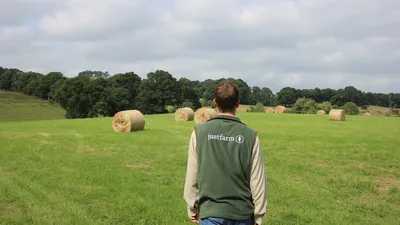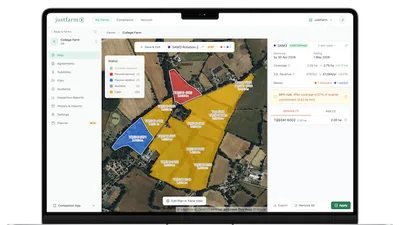NUM2 - Legumes on Improved Grassland
Payment
You’ll receive £102 per hectare per year.
Aim
This action aims to ensure that legumes are growing from spring until early autumn. This is intended to:
- Manage nutrient efficiency.
- Protect the soil surface.
- Provide root growth that maintains soil structure, supports soil biology, and minimizes nutrient leaching, soil erosion, and runoff.
- Support an IPM approach if located close to cropped areas.
Where You Can Do This Action
You can do this action on eligible agricultural land located below the moorland line. The table below sets out what land is eligible for NUM2.
Table 22: Eligible land for NUM2
| Eligible land type | Eligible land use code | Compatible land cover |
|---|---|---|
| Temporary grassland | TG01 | Arable land |
| Improved permanent grassland | PG01 | Permanent grassland |
The glossary (annex C) explains what we mean by land types, land use codes and compatible land covers.
The SFI application service will automatically calculate what area may be eligible for this action in each land parcel. This is called the ‘SFI available area’. You must check this area is an eligible land type. Find out how the SFI available area is calculated in the information on land that’s eligible for the SFI actions (section 4.1.2).
You can apply for this action on either the total SFI available area in each land parcel shown in your SFI application, or part of that area.
This action is rotational. You can do it on the same area of eligible land each year of your 3-year SFI agreement, or you can move the area each year.
You must not enter any area within a land parcel into this action that contains historic or archaeological features identified in your SFI HEFER. Read the information about historic and archaeological features, including scheduled monuments (section 4.3.2) to find out more about the SFI HEFER.
You should also not enter any area of land into this action that has peaty soil because this action could damage peat. Peaty soil means there’s around 20% or more organic matter to a depth of 40cm or more. The SOM test results from completing action SAM1 will tell you if this is the case.
Other Land Management Actions or Options You Can Do on the Same Area as NUM2
The table below sets out which other SFI actions, CS management options, ES revenue options and SFI pilot standards can be located on the same eligible area within a land parcel as NUM2.
Table 23: Actions or options that can be located on the same area within a land parcel as NUM2
| Scheme | Action or option codes that can be located on the same area as NUM2 |
|---|---|
| SFI 2023 | SAM1, IPM1, NUM1 |
| CS | OR3, OT1, OT3, OR1 |
| ES | No ES revenue options |
| SFI pilot | No area-based SFI pilot standards |
Use the CS grant finder to search for the CS option codes shown above.
The SFI actions for hedgerows (HRW1, HRW2 and HRW3), CS option BE3 and the introductory level of the SFI pilot hedgerows standard can be done on the eligible boundaries of a land parcel entered into NUM2.
If an action or option cannot be located on the same area within a land parcel as NUM2, this is because it’s not an eligible land type, or the activities are incompatible, or you would be paid twice for doing the same activities on the same land. In this case, that area will be automatically removed from the affected land parcel’s SFI available area in your SFI application.
If this is the case, you may be able to do the action on a different area in the same land parcel if:
- it’s an eligible land type for the action or option
- it’s a part-parcel action or option
- the area used for the action or option does not overlap with the area used for NUM2
Read the information about eligibility of land used for other schemes and funding sources (section 4.2) to find out more.
What To Do
You must establish and maintain legumes on improved grassland entered into this action.
You can use one or more type of legume, such as:
- red clover
- white clover
- alsike clover
- sainfoin
- lucerne
- bird’s foot trefoil
You can establish the legumes by:
- adding them to an existing grass sward
- sowing a mix of grass and legumes
Once established, you must maintain the legumes. To do this, you must manage them in a way that could reasonably be expected to achieve this action’s aim.
You can maintain existing areas of legumes on improved grassland to meet this action if they:
- meet the requirements explained above
- are not already being for under another environmental land management scheme option, such as CS option GS4 (legume and herb-rich swards)
When to Do It
If you’re doing this action on the same area of land for the 3-year duration of your SFI agreement, you must:
- establish the legumes during the first 12 months of your SFI agreement
- maintain the area of legumes in each subsequent year of your SFI agreement
If you’re rotating this action around your farm, each year of your SFI agreement you must do it for a period of time that could reasonably be expected to achieve this action’s aim.
How to Do It
It’s up to you how you complete this action, as long as you do it in a way that can reasonably be expected to achieve this action’s aim.
You may find it helpful to read the voluntary guidance on how to establish and maintain legumes on improved grassland, but you do not have to follow it.
What Evidence to Keep
You should keep evidence to show what you’ve done to complete this action. This will help if it’s not clear that you’ve completed the action in a way that could reasonably be expected to achieve this action’s aim. You must supply this evidence if we ask for it.
This evidence could include photographs and other documentation to show what you’ve done to complete this action. It could also include field operations at a land parcel level and associated invoices. If you choose to take photographs, read the guidance on how to take photographic evidence (annex A).
Contains public sector information licensed under the Open Government Licence v3.0. Source: SFI Handbook for the SFI 2023 Offer




